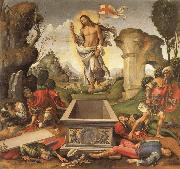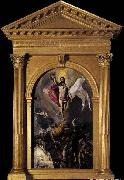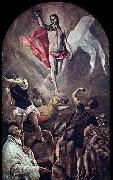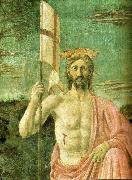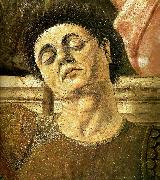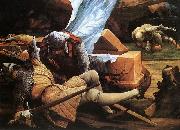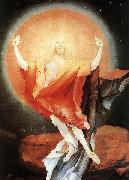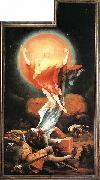Wholesale Oil Painting No Minimum |
|||||||||||
|
|
|||||||||||

|
|||||||||||
|
|
|
||||||||
Raffaellino del garboItalian Early Renaissance Painter , ca.1466-1524 Italian painter and draughtsman. According to Vasari, he began as the most gifted assistant of Filippino Lippi and the most promising painter of the new generation but never fulfilled expectations, deteriorating into mediocrity and worse. Raffaellino's first known work is the frescoed vault of a small antechamber off Filippino Lippi's Carafa Chapel in S Maria sopra Minerva, Rome, uncovered during restoration in the 1960s. It was decorated with pagan themes, to Filippino's designs, apparently after the main chapel was completed in 1493. Filippino's influence is evident in the all'antica detail and animated figure style, to which Raffaellino brought a youthful freshness and charm. Vasari, in his account of the vault, likened it to an illuminator's work. It has been suggested that Raffaellino remained in Rome and worked with Bernardino Pinturicchio in the Borgia apartments in the Vatican, where some frescoes of 1495 show stylistic affinities with Raffaellino's work in S Maria sopra Minerva. |
||||||||
|
|
||||||||
The Resurrection
The Resurrection Painting ID:: 29769 |
mk67
Oil on panel
68 11/16x73 7/16in
mk67 Oil on panel 68 11/16x73 7/16in |
|||||||
|
|
||||||||
El GrecoGreek-born Spanish Mannerist Painter, 1541-1614 Considered a representative of late Renaissance Spanish art, El Greco was actually born in Greece, on the island of Crete. After studying in Venice under Titian, El Greco settled in Toledo, Spain in 1577. At the time he was wildly popular, his emotionally religious paintings being just the ticket for the hometown of the Spanish Inquisition. After his death his work was largely ignored until the beginning of the 20th century; now he considered one of the inspired geniuses of Western art. His distinctive style features bold shapes and colors, with elongated and slightly distorted figures. In Toledo El Greco was in constant demand and liked living large: he maintained a private orchestra to accompany his meals. |
||||||||
|
|
||||||||
|
|
The Resurrection
The Resurrection Painting ID:: 40396 |
mk156
c.1590
Oil on canvas
275x127cm
mk156 c.1590 Oil on canvas 275x127cm |
||||||
|
|
||||||||
El GrecoGreek-born Spanish Mannerist Painter, 1541-1614 Considered a representative of late Renaissance Spanish art, El Greco was actually born in Greece, on the island of Crete. After studying in Venice under Titian, El Greco settled in Toledo, Spain in 1577. At the time he was wildly popular, his emotionally religious paintings being just the ticket for the hometown of the Spanish Inquisition. After his death his work was largely ignored until the beginning of the 20th century; now he considered one of the inspired geniuses of Western art. His distinctive style features bold shapes and colors, with elongated and slightly distorted figures. In Toledo El Greco was in constant demand and liked living large: he maintained a private orchestra to accompany his meals. |
||||||||
|
|
||||||||
|
|
The resurrection
The resurrection Painting ID:: 42679 |
MK169
ca.1597-1604 Shut down 275x127cm Prado, Madrid MK169 ca.1597-1604 Shut down 275x127cm Prado, Madrid |
||||||
|
|
||||||||
GRECO, ElGreek-born Spanish Mannerist Painter, 1541-1614 Greek painter, designer and engraver, active in Italy and Spain. One of the most original and interesting painters of 16th-century Europe, he transformed the Byzantine style of his early paintings into another, wholly Western manner. He was active in his native Crete, in Venice and Rome, and, during the second half of his life, in Toledo. He was renowned in his lifetime for his originality and extravagance and provides one of the most curious examples of the oscillations of taste in the evaluation of a painter, |
||||||||
|
|
||||||||
|
|
The Resurrection
The Resurrection Painting ID:: 43745 |
Oil on canvas,
275 x 127 cm Oil on canvas, 275 x 127 cm |
||||||
|
|
||||||||
Matthias GrunewaldGerman 1475-1528 Matthias Grunewald Galleries Only religious works are included in his small surviving corpus, the most famous being the Isenheim Altarpiece, completed 1515, now in the Musee d'Unterlinden, Colmar. Its nine images on twelve panels contain scenes of the Annunciation, Mary bathing Christ, Crucifixion, Entombment of Christ, Resurrection, Temptation of St. Anthony and saints. As was common in the preceding century, there are different views, depending on the arrangement of the wings; but the three views available here are exceptional. The third view discloses a carved and gilded wood altarpiece in the centre. As well as being by far his greatest surviving work, the altarpiece contains most of his surviving painting by area, being 2.65 metres high and over 5 metres wide at its fullest extent. His other works are in Germany, except for a small Crucifixion in Washington and another in Basel, Switzerland. He was asked in about 1510 to paint four saints in grisaille for the outside of the wings of Durer's Heller Altarpiece in Frankfurt. D??rer's work was destroyed by fire and only survives in copies, but fortunately the wings have survived. There are also the late Tauberbischofsheim altarpiece in Karlsruhe, and the Establishment of the Santa Maria Maggiore in Rome (1517-1519), Freiburg, Augustinermuseum. A large panel of Saint Erasmus and Saint Maurice in Munich probably dates from 1521-24, and was apparently part of a larger altarpiece project, the rest of which has not survived. Other works are in Munich, Karlsruhe, and Rhineland churches. Altogether four somber and awe-filled Crucifixions survive. The visionary character of his work, with its expressive colour and line, is in stark contrast to Albrecht Durer's works. His paintings are known for their dramatic forms, vivid colors, and depiction of light. |
||||||||
|
|
||||||||
|
|
The Resurrection
The Resurrection Painting ID:: 52036 |
c. 1515 Oil on wood c. 1515 Oil on wood |
||||||
|
|
||||||||
El GrecoGreek-born Spanish Mannerist Painter, 1541-1614 Considered a representative of late Renaissance Spanish art, El Greco was actually born in Greece, on the island of Crete. After studying in Venice under Titian, El Greco settled in Toledo, Spain in 1577. At the time he was wildly popular, his emotionally religious paintings being just the ticket for the hometown of the Spanish Inquisition. After his death his work was largely ignored until the beginning of the 20th century; now he considered one of the inspired geniuses of Western art. His distinctive style features bold shapes and colors, with elongated and slightly distorted figures. In Toledo El Greco was in constant demand and liked living large: he maintained a private orchestra to accompany his meals. |
||||||||
|
|
||||||||
|
|
The Resurrection
The Resurrection Painting ID:: 53573 |
mk233
Oil on canvas
275x127cm
mk233 Oil on canvas 275x127cm |
||||||
|
|
||||||||
GRECO, ElGreek-born Spanish Mannerist Painter, 1541-1614 Greek painter, designer and engraver, active in Italy and Spain. One of the most original and interesting painters of 16th-century Europe, he transformed the Byzantine style of his early paintings into another, wholly Western manner. He was active in his native Crete, in Venice and Rome, and, during the second half of his life, in Toledo. He was renowned in his lifetime for his originality and extravagance and provides one of the most curious examples of the oscillations of taste in the evaluation of a painter, |
||||||||
|
|
||||||||
|
|
The Resurrection
The Resurrection Painting ID:: 62351 |
210 x 128 cm Church of Santo Domingo el Antiguo, Toledo Painted for the side altar on the Epistle side (right) of the church, and still in place. Probably painted 1578-79, following the completion of the High Altarpiece. The presence of Saint Ildefonso, the patron Saint of Toledo, was stipulated in the documents. Diego de Castilla, the Dean of Toledo Cathedral, is probably represented in this figure, which certainly is a portrait. The figure assists in setting an ideal plane for the enacting of the mystic event. El Greco has eliminated the intrusion of an incongruous space. The ground running parallel with the plane of the action produces no conflict. The rhythm of the passages of colour and light over the surface helps to hold together the composition, with its dramatic split revealing the figure of the Risen Christ. What suggestions remain of an ordinary conception of space, of corporeality and of a schematic quality of composition, disappear in his final version of the subject (painted in 1596-1600, now in the Prado, Madrid). Author: GRECO, El Title: The Resurrection , 1551-1600 , Spanish Form: painting , religious 210 x 128 cm Church of Santo Domingo el Antiguo, Toledo Painted for the side altar on the Epistle side (right) of the church, and still in place. Probably painted 1578-79, following the completion of the High Altarpiece. The presence of Saint Ildefonso, the patron Saint of Toledo, was stipulated in the documents. Diego de Castilla, the Dean of Toledo Cathedral, is probably represented in this figure, which certainly is a portrait. The figure assists in setting an ideal plane for the enacting of the mystic event. El Greco has eliminated the intrusion of an incongruous space. The ground running parallel with the plane of the action produces no conflict. The rhythm of the passages of colour and light over the surface helps to hold together the composition, with its dramatic split revealing the figure of the Risen Christ. What suggestions remain of an ordinary conception of space, of corporeality and of a schematic quality of composition, disappear in his final version of the subject (painted in 1596-1600, now in the Prado, Madrid). Author: GRECO, El Title: The Resurrection , 1551-1600 , Spanish Form: painting , religious |
||||||
|
|
||||||||
GRECO, ElGreek-born Spanish Mannerist Painter, 1541-1614 Greek painter, designer and engraver, active in Italy and Spain. One of the most original and interesting painters of 16th-century Europe, he transformed the Byzantine style of his early paintings into another, wholly Western manner. He was active in his native Crete, in Venice and Rome, and, during the second half of his life, in Toledo. He was renowned in his lifetime for his originality and extravagance and provides one of the most curious examples of the oscillations of taste in the evaluation of a painter, |
||||||||
|
|
||||||||
|
|
The Resurrection
The Resurrection Painting ID:: 62352 |
210 x 128 cm Church of Santo Domingo el Antiguo, Toledo Painted for the side altar on the Epistle side (right) of the church, and still in place. Probably painted 1578-79, following the completion of the High Altarpiece. The presence of Saint Ildefonso, the patron Saint of Toledo, was stipulated in the documents. Diego de Castilla, the Dean of Toledo Cathedral, is probably represented in this figure, which certainly is a portrait. The figure assists in setting an ideal plane for the enacting of the mystic event. El Greco has eliminated the intrusion of an incongruous space. The ground running parallel with the plane of the action produces no conflict. The rhythm of the passages of colour and light over the surface helps to hold together the composition, with its dramatic split revealing the figure of the Risen Christ. What suggestions remain of an ordinary conception of space, of corporeality and of a schematic quality of composition, disappear in his final version of the subject (painted in 1596-1600, now in the Prado, Madrid). Author: GRECO, El Title: The?Resurrection , 1551-1600 , Spanish Form: painting , religious 210 x 128 cm Church of Santo Domingo el Antiguo, Toledo Painted for the side altar on the Epistle side (right) of the church, and still in place. Probably painted 1578-79, following the completion of the High Altarpiece. The presence of Saint Ildefonso, the patron Saint of Toledo, was stipulated in the documents. Diego de Castilla, the Dean of Toledo Cathedral, is probably represented in this figure, which certainly is a portrait. The figure assists in setting an ideal plane for the enacting of the mystic event. El Greco has eliminated the intrusion of an incongruous space. The ground running parallel with the plane of the action produces no conflict. The rhythm of the passages of colour and light over the surface helps to hold together the composition, with its dramatic split revealing the figure of the Risen Christ. What suggestions remain of an ordinary conception of space, of corporeality and of a schematic quality of composition, disappear in his final version of the subject (painted in 1596-1600, now in the Prado, Madrid). Author: GRECO, El Title: The?Resurrection , 1551-1600 , Spanish Form: painting , religious |
||||||
|
|
||||||||
Piero della FrancescaItalian Early Renaissance Painter, ca.1422-1492 Italian painter and theorist. His work is the embodiment of rational, calm, monumental painting in the Italian Early Renaissance, an age in which art and science were indissolubly linked through the writings of Leon Battista Alberti. Born two generations before Leonardo da Vinci, Piero was similarly interested in the scientific application of the recently discovered rules of perspective to narrative or devotional painting, especially in fresco, of which he was an imaginative master; and although he was less universally creative than Leonardo and worked in an earlier idiom, he was equally keen to experiment with painting technique. Piero was as adept at resolving problems in Euclid, whose modern rediscovery is largely due to him, as he was at creating serene, memorable figures, whose gestures are as telling and spare as those in the frescoes of Giotto or Masaccio. His tactile, gravely convincing figures are also indebted to the sculpture of Donatello, an equally attentive observer of Classical antiquity. In his best works, such as the frescoes in the Bacci Chapel in S Francesco, Arezzo, there is an ideal balance between his serene, classical compositions and the figures that inhabit them, the whole depicted in a distinctive and economical language. In his autograph works Piero was a perfectionist, creating precise, logical and light-filled images (although analysis of their perspective schemes shows that these were always subordinated to narrative effect). However, he often delegated important passages of works (e.g. the Arezzo frescoes) to an ordinary, even incompetent, assistant. |
||||||||
|
|
||||||||
|
|
the resurrection
the resurrection Painting ID:: 64954 |
details
se details se |
||||||
|
|
||||||||
Piero della FrancescaItalian Early Renaissance Painter, ca.1422-1492 Italian painter and theorist. His work is the embodiment of rational, calm, monumental painting in the Italian Early Renaissance, an age in which art and science were indissolubly linked through the writings of Leon Battista Alberti. Born two generations before Leonardo da Vinci, Piero was similarly interested in the scientific application of the recently discovered rules of perspective to narrative or devotional painting, especially in fresco, of which he was an imaginative master; and although he was less universally creative than Leonardo and worked in an earlier idiom, he was equally keen to experiment with painting technique. Piero was as adept at resolving problems in Euclid, whose modern rediscovery is largely due to him, as he was at creating serene, memorable figures, whose gestures are as telling and spare as those in the frescoes of Giotto or Masaccio. His tactile, gravely convincing figures are also indebted to the sculpture of Donatello, an equally attentive observer of Classical antiquity. In his best works, such as the frescoes in the Bacci Chapel in S Francesco, Arezzo, there is an ideal balance between his serene, classical compositions and the figures that inhabit them, the whole depicted in a distinctive and economical language. In his autograph works Piero was a perfectionist, creating precise, logical and light-filled images (although analysis of their perspective schemes shows that these were always subordinated to narrative effect). However, he often delegated important passages of works (e.g. the Arezzo frescoes) to an ordinary, even incompetent, assistant. |
||||||||
|
|
||||||||
|
|
the resurrection
the resurrection Painting ID:: 64955 |
details
se details se |
||||||
|
|
||||||||
Matthias GrunewaldGerman Northern Renaissance Painter, ca.1470-1528,was an important German Renaissance painter of religious works, who ignored Renaissance classicism to continue the expressive and intense style of late medieval Central European art into the 16th century. Only ten paintings (several consisting of many panels) and thirty-five drawings survive, all religious, although many others were lost at sea in the Baltic on their way to Sweden as war booty. His reputation was obscured until the late nineteenth century, and many of his paintings were attributed to Albrecht D??rer, who is now seen as his stylistic antithesis. His largest and most famous work is the Isenheim Altarpiece in Colmar, Alsace (now in France). The details of his life are unusually unclear for a painter of his significance at this date, despite the fact that his commissions show that he had reasonable recognition in his own lifetime. His real name remains uncertain, but was definitely not Grunewald; this was a mistake by the 17th-century writer, Joachim von Sandrart, who confused him with another artist. He is documented as "Master Mathis" or "Mathis the Painter" (Mathis der Maler), and as using as surname both Gothart and Neithardt - this last may have been his surname, or more likely that of his wife. He was probably born in Wurzburg in the 1470s. It is possible he was a pupil of Hans Holbein the Elder. From about 1500 he seems to have lived at Seligenstadt, when not working elsewhere. His first dated painting is probably in Munich, dated 1503 on a much later note which apparently records an older inscription. From about 1510 to 1525 he served in the Rhineland as court painter, |
||||||||
|
|
||||||||
|
|
The Resurrection
The Resurrection Painting ID:: 91256 |
1515(1515)
Medium oil on panel
cyf 1515(1515) Medium oil on panel cyf |
||||||
|
|
||||||||
Matthias GrunewaldGerman Northern Renaissance Painter, ca.1470-1528,was an important German Renaissance painter of religious works, who ignored Renaissance classicism to continue the expressive and intense style of late medieval Central European art into the 16th century. Only ten paintings (several consisting of many panels) and thirty-five drawings survive, all religious, although many others were lost at sea in the Baltic on their way to Sweden as war booty. His reputation was obscured until the late nineteenth century, and many of his paintings were attributed to Albrecht D??rer, who is now seen as his stylistic antithesis. His largest and most famous work is the Isenheim Altarpiece in Colmar, Alsace (now in France). The details of his life are unusually unclear for a painter of his significance at this date, despite the fact that his commissions show that he had reasonable recognition in his own lifetime. His real name remains uncertain, but was definitely not Grunewald; this was a mistake by the 17th-century writer, Joachim von Sandrart, who confused him with another artist. He is documented as "Master Mathis" or "Mathis the Painter" (Mathis der Maler), and as using as surname both Gothart and Neithardt - this last may have been his surname, or more likely that of his wife. He was probably born in Wurzburg in the 1470s. It is possible he was a pupil of Hans Holbein the Elder. From about 1500 he seems to have lived at Seligenstadt, when not working elsewhere. His first dated painting is probably in Munich, dated 1503 on a much later note which apparently records an older inscription. From about 1510 to 1525 he served in the Rhineland as court painter, |
||||||||
|
|
||||||||
|
|
The Resurrection
The Resurrection Painting ID:: 91257 |
1515(1515)
Medium oil on panel
cyf 1515(1515) Medium oil on panel cyf |
||||||
|
|
||||||||
Matthias GrunewaldGerman Northern Renaissance Painter, ca.1470-1528,was an important German Renaissance painter of religious works, who ignored Renaissance classicism to continue the expressive and intense style of late medieval Central European art into the 16th century. Only ten paintings (several consisting of many panels) and thirty-five drawings survive, all religious, although many others were lost at sea in the Baltic on their way to Sweden as war booty. His reputation was obscured until the late nineteenth century, and many of his paintings were attributed to Albrecht D??rer, who is now seen as his stylistic antithesis. His largest and most famous work is the Isenheim Altarpiece in Colmar, Alsace (now in France). The details of his life are unusually unclear for a painter of his significance at this date, despite the fact that his commissions show that he had reasonable recognition in his own lifetime. His real name remains uncertain, but was definitely not Grunewald; this was a mistake by the 17th-century writer, Joachim von Sandrart, who confused him with another artist. He is documented as "Master Mathis" or "Mathis the Painter" (Mathis der Maler), and as using as surname both Gothart and Neithardt - this last may have been his surname, or more likely that of his wife. He was probably born in Wurzburg in the 1470s. It is possible he was a pupil of Hans Holbein the Elder. From about 1500 he seems to have lived at Seligenstadt, when not working elsewhere. His first dated painting is probably in Munich, dated 1503 on a much later note which apparently records an older inscription. From about 1510 to 1525 he served in the Rhineland as court painter, |
||||||||
|
|
||||||||
|
|
The Resurrection
The Resurrection Painting ID:: 91258 |
1515(1515)
Medium oil on panel
cyf 1515(1515) Medium oil on panel cyf |
||||||
|
|
||||||||
Luca Giordano1632-1705 Italian Luca Giordano Gallery Charles II of Spain towards 1687 invited him over to Madrid, where he remained for 10 years (1692-1702). In Spain, he produced works for the Royal Palace of Madrid, the Buen Retiro palace, El Escorial, Toledo, and other sites. Giordano was popular at the Spanish court, and the king granted him title as a "caballero". One anecdote of Giordano's speed at painting is that, he was once asked by the Queen of Spain what his wife looked like. On the spot, he painted his wife into the picture before him for the Queen. In Spain he executed numerous works, continuing in the Escorial the series commenced by Cambiasi, and painting frescoes of the Triumphs of the Church, the Genealogy and Life of the Madonna, the stories of Moses, Gideon, David and the Celebrated Women of Scripture, all works of large dimensions. His Dream of Solomon (1693, now at Prado) dates from this period. His pupils, Aniello Rossi and Matteo Pacelli, assisted him in Spain. In Madrid he worked more in oil-colour, a Nativity there being one of his best productions. |
||||||||
|
|
||||||||
|
|
The Resurrection
The Resurrection Painting ID:: 95737 |
after 1665(1665)
Medium oil on canvas
cyf after 1665(1665) Medium oil on canvas cyf |
||||||
|
|
||||||||
|
Luca Giordano 1632-1705 Italian Luca Giordano Gallery Charles II of Spain towards 1687 invited him over to Madrid, where he remained for 10 years (1692-1702). In Spain, he produced works for the Royal Palace of Madrid, the Buen Retiro palace, El Escorial, Toledo, and other sites. Giordano was popular at the Spanish court, and the king granted him title as a "caballero". One anecdote of Giordano's speed at painting is that, he was once asked by the Queen of Spain what his wife looked like. On the spot, he painted his wife into the picture before him for the Queen. In Spain he executed numerous works, continuing in the Escorial the series commenced by Cambiasi, and painting frescoes of the Triumphs of the Church, the Genealogy and Life of the Madonna, the stories of Moses, Gideon, David and the Celebrated Women of Scripture, all works of large dimensions. His Dream of Solomon (1693, now at Prado) dates from this period. His pupils, Aniello Rossi and Matteo Pacelli, assisted him in Spain. In Madrid he worked more in oil-colour, a Nativity there being one of his best productions. The Resurrection after 1665(1665) Medium oil on canvas cyf |
||||||||
|
|
||||||||
|
Prev Next
|
||||||||
|
|
||||||||
|
Related Paintings to Luca Giordano :. |
||||||||
|
|
||||||||
|
CONTACT US |
